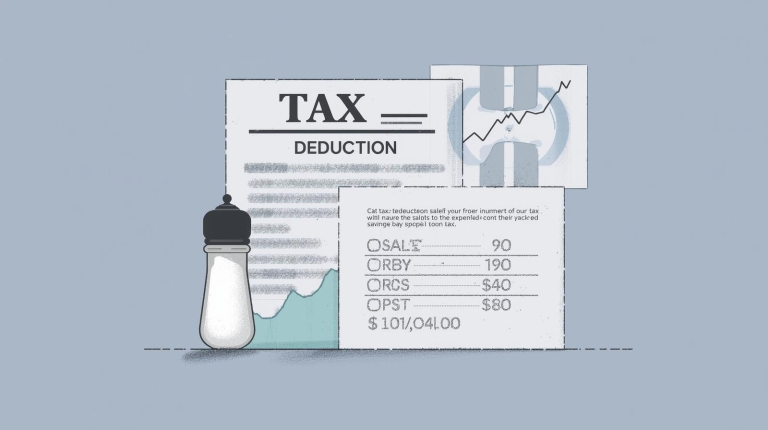By now, you may have heard about updates to the SALT (State and Local Tax) itemized deduction. While most headlines focus on places like New York and California, this change has the potential to affect wherever you live as well—particularly those with higher property taxes or higher incomes.
I want to explain what this really means for you, why it was introduced, and whether you might benefit from it. Spoiler: it won’t apply to everyone, but for certain taxpayers it could mean thousands of dollars in savings.
First Things First: What Is the SALT Deduction?
The SALT deduction allows you to deduct certain taxes you pay to state and local governments from your federal taxable income when you itemize your deductions.
This includes:
Property taxes on your home or other real estate
- Income taxes to your state and locality
Certain personal property taxes like vehicle registration fees tied to value
The SALT deduction has been part of the U.S. tax code for a long time, but it became a hot topic after the 2017 Tax Cuts and Jobs Act capped it at $10,000 per year. That cap hit taxpayers in high-tax states especially hard.
The Problem With the Old $10,000 Cap
Most middle-income families weren’t hurt as much by the $10,000 SALT cap because our property taxes and income tax rates aren’t as high as states like New Jersey or New York.
However, the law also benefited you by almost doubling the standard deduction. That meant fewer people itemized their deductions at all, because the standard deduction was higher than their itemized total. For many households, it became simpler and more beneficial to take the standard deduction. For most of you, these changes were really a net benefit.
The 2025 Change: SALT Deduction Temporarily Expanded
Under the new 2025 tax act, the SALT deduction cap has been temporarily increased from $10,000 to $40,000. This applies for tax years 2025 through 2029.
Here’s what that means in practice:
If your combined state income taxes, property taxes, and certain license fees exceed $10,000, you may now be able to deduct up to $40,000 of them.
If your total itemized deductions (SALT + mortgage interest + charitable contributions, etc.) exceed the standard deduction, it may make sense to itemize again.
This opens the door—especially those in higher-income brackets or with higher property taxes—to reduce their federal taxable income, though this may be tempered by the phase-outs.
Income Phaseouts to Keep in Mind
There are phaseouts that limit who gets the full benefit.
Single filers: Phaseout begins above $250,000 MAGI
Married filing jointly: Phaseout begins above $500,000 MAGI
The deduction phases out at 30 cents for every $1 of income above these limits until it reverts back to the original $10,000 cap
That means very high-income and property tax households may not be able to realize the full $40,000 benefit. So, you may not be able to realize the entire benefit but some portion may still be on the table for you.
Why This Matters to You
Even though you may not live in a particularly “high tax” state, property taxes here can be substantial, no matter where you live. Home values have increased in many parts of the country, especially in desirable school districts, and with that comes higher property tax bills.
But remember: this isn’t a broad middle-class tax cut. For most households, the standard deduction will still make more sense. The people who benefit most are those already paying higher property taxes and state taxes.
Planning Ahead: Should You Itemize Again?
Here’s what I recommend as a CPA:
Gather Your Numbers – Add up your property taxes, state taxes, mortgage interest, and charitable contributions.
Compare Against the Standard Deduction – For 2025, the standard deduction will also adjust upward for inflation. We’ll need to compare totals each year.
Run the Phaseout Test – If your income is above the $250,000/$500,000 threshold, calculate how much of the $40,000 deduction you actually get.
Talk With a CPA (Me!) – Every situation is different, and itemizing only makes sense if it reduces your taxable income more than the standard deduction.
The Bottom Line
For most taxpayers, this change won’t alter much—you’ll still take the standard deduction. But for higher-income families and homeowners with significant property taxes, the expanded SALT deduction may be worth thousands in tax savings between 2025 and 2029.
Since this is temporary, it’s important to take advantage of it while it lasts. Planning now could save you meaningful money over the next few years.
Let’s Talk About Your Situation
I know tax law changes can feel overwhelming, but that’s why I’m here. If you are wondering whether you should itemize under the new SALT rules, let’s run the numbers together. You’ll always work directly with me—no call centers, no hand-offs. Just straightforward tax guidance from someone who knows the tax landscape.
Reach out today either by calling me (248-909-2880), replying to this newsletter,
emailing me directly or through https://persitzcpa.com, and let’s make sure you take advantage of every opportunity available to you.
Disclaimer:
The information provided in this blog/newsletter is for general informational purposes only and does not constitute tax, legal, or accounting advice. Every taxpayer’s situation is unique, and tax laws are subject to change. You should consult with a qualified tax professional before making any financial decisions based on this content.
If you’d like personalized guidance or have questions about how these topics apply to your specific circumstances, I’d be happy to help. Please feel free to contact me to schedule a consultation.
-Mark Persitz, CPA



